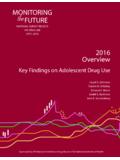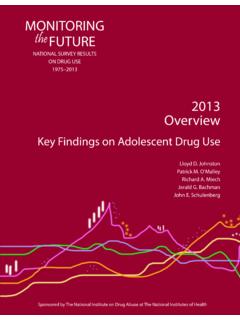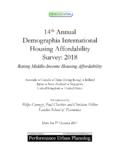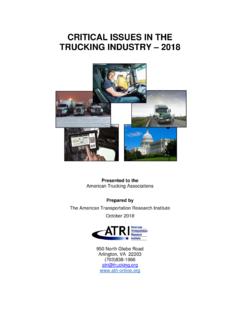Transcription of MONITORING FUTURE the
1 MONITORING . the FUTURE . NATIONAL survey RESULTS. ON DRUG USE. 1975 2018 . 2018 . Overview Key Findings on Adolescent Drug Use Lloyd D. Johnston Richard A. Miech Patrick M. O'Malley Jerald G. Bachman John E. Schulenberg Megan E. Patrick Sponsored by The National Institute on Drug Abuse at The National Institutes of Health MONITORING THE FUTURE . NATIONAL survey RESULTS ON DRUG USE, 1975 2018 . 2018 Overview Key Findings on Adolescent Drug Use Lloyd D. Johnston, Richard A. Miech, Patrick M. O'Malley, Jerald G. Bachman, John E. Schulenberg, Megan E. Patrick, Institute for Social Research The University of Michigan Sponsored by National Institute on Drug Abuse The National Institutes of Health Published January 2019. This publication was written by the principal investigators and staff of the MONITORING the FUTURE project at the Institute for Social Research, the University of Michigan, under Research Grant R01 DA.
2 001411 from the National Institute on Drug Abuse. The findings and conclusions in this report are those of the authors and do not necessarily represent the views of the sponsor. Public Domain Notice All material appearing in this volume is in the public domain and may be reproduced or copied, whether in print or non-print media including derivatives, in any reasonable manner, without permission from the authors. To modify the material, please contact the MONITORING the FUTURE Project at for verification of accuracy. Citation of the source is appreciated, including at least the following: MONITORING the FUTURE , Institute for Social Research, University of Michigan. Recommended Citation Johnston, L. D., Miech, R. A., O'Malley, P. M., Bachman, J. G., Schulenberg, J. E., & Patrick, M. E. (2019). MONITORING the FUTURE national survey results on drug use 1975- 2018 : Overview, key findings on adolescent drug use.
3 Ann Arbor: Institute for Social Research, University of Michigan. Institute for Social Research The University of Michigan Ann Arbor, Michigan Printed January 2019. i Contents Summary of Key Findings ..1. Introduction ..5. Study Design and Methods ..7. Specific Results by Drug Any Illicit Drug ..9. Marijuana ..11. Synthetic Marijuana ..13. Inhalants ..15. LSD ..17. Cocaine ..19. Crack ..21. Amphetamines and Other Stimulant Drugs ..23. Methamphetamine and Crystal Methamphetamine (Ice) ..25. Heroin ..27. Other Narcotic Drugs, Including OxyContin and Vicodin ..29. Tranquilizers ..31. Sedatives (Barbiturates) ..33. MDMA (Ecstasy, Molly) and Other Club Drugs ..35. Cigarettes ..39. Smokeless Vaping ..43. Other Tobacco Steroids ..47. Subgroup Differences ..49. Lessons Tables 1. Trends in Lifetime Prevalence of Use of Various Drugs for Grades 8, 10, and 12 2. Trends in Annual Prevalence of Use of Various Drugs for Grades 8, 10, and 12 3.
4 Trends in 30 Day Prevalence of Use of Various Drugs for Grades 8, 10, and 12 ii 4. Trends in Daily Prevalence of Use of Selected Drugs and Heavy Use of Alcohol and Tobacco for Grades 8, 10, and 12 Combined ..60. 5. Trends in Lifetime Prevalence of Use of Various Drugs in Grades 8, 10, and 12 ..62. 6. Trends in Annual Prevalence of Use of Various Drugs in Grades 8, 10, and 12 ..69. 7. Trends in 30 day Prevalence of Use of Various Drugs in Grades 8, 10, and 12 ..79. 8. Trends in 30 Day Prevalence of Daily Use of Various Drugs in Grades 8, 10, and 12 ..87. 9. Trends in Two Week Prevalence of Extreme Binge Drinking in Grade 12 ..89. 10. Trends in Harmfulness of Drugs as Perceived by 8th Graders ..93. 11. Trends in Harmfulness of Drugs as Perceived by 10th Graders ..96. 12. Trends in Harmfulness of Drugs as Perceived by 12th Graders ..99. 13. Trends in Disapproval of Drug Use in Grade 8.
5 103. 14. Trends in Disapproval of Drug Use in Grade 10 ..106. 15. Trends in Disapproval of Drug Use in Grade 12 ..109. 16. Trends in Availability of Drugs as Perceived by 8th Graders ..113. 17. Trends in Availability of Drugs as Perceived by 10th Graders ..115. 18. Trends in Availability of Drugs as Perceived by 12th Graders ..117. iii Summary of Key Findings MONITORING the FUTURE (MTF) is a long-term study of substance use and related factors among adolescents, college students, and adult high school graduates through age 60. It is conducted annually and supported by the National Institute on Drug Abuse. MTF. findings identify emerging substance use problems, track substance use trends, and inform national policy and intervention strategies. MTF is designed to detect age, period, and cohort effects in substance use and related attitudes. Age effects are similar changes with age seen across multiple class cohorts; they are common during adolescence.
6 Period effects are changes that are parallel over a number of years across multiple age groups (in this case, all three grades under study 8, 10, and 12). Cohort effects are consistent differences among birth cohorts (or in this case, class cohorts) that are then maintained as the cohorts age. The key findings regarding use of various substances by 8th, 10th, and 12th graders surveyed across the coterminous in 2018 are summarized below. The analyses and associated tables and figures that follow tracked since the mid-1990s in reducing cigarette present substance use trends for all three grades smoking among adolescents. separately, as well as trends in key attitudes, beliefs, and perceived availability. In a number of cases we provide Little Change in Marijuana or the Three Indexes insight into the age, period, and cohort effects that of Overall Drug Use underlie trends in use and in key attitudes and beliefs.
7 Annual marijuana prevalence rose by a nonsignificant percentage points to in 2018 based on data An additional set of tables provides an overview of drug from the three grades This follows a use trends for the three grades combined (Tables 1 4). significant increase in 2017. Annual prevalence stands at This information gives a summary of the general nature 11%, 28%, and 36% in grades 8, 10, and 12. Daily of historical trends over the last several years, though it marijuana prevalence changed little this year, with rates obscures any age or cohort effects that may be occurring. at 1%, 3%, and 6%, respectively. Also, for simultaneous trends that are in the same direction and magnitude across all three grades, these Annual use of any illicit drug, which tends to be driven combined analyses provide greater statistical power to by marijuana by far the most prevalent of the illicit detect whether trends are statistically significant.
8 Drugs also rose nonsignificantly in grades 8 and 10, but declined nonsignificantly in 12th grade. Change in 2018 . One Form of Drug Use Showed a Sharp Increase for the three grades combined also did not reach in Use in 2018 significance. Since 2006 there has been rather little The most important finding to emerge from the 2018 systematic change in this index. survey is the dramatic increase in vaping by Vaping is a relatively new phenomenon, so we are still The index of any illicit drug other than marijuana developing measures related to this behavior, which showed no change in annual prevalence in 2018 for the included asking separately for the first time in 2017 about three grades combined, but has shown a very gradual the vaping of three specific substances nicotine, decline since 2001 when it was 16% compared to 2018 . marijuana, and just flavoring. As the section on vaping when it was 9%.
9 In this monograph shows, there was a significant and substantial increase in 2018 in the vaping of all three of The annual prevalence of the index of any illicit drug these substances, including some of the largest absolute including inhalants changed little in 2018 for the three increases MTF has ever tracked for any substance. Given grades combined, after rising significantly the previous that nicotine is involved in most vaping, and given that Since 2006 there has been little systematic change nicotine is a highly addictive substance, this presents a in this index. serious threat to all of the hard-won progress that we have 1. Vaping involves the inhalation of aerosols (sometimes including nicotine) using vaping prevalence, which grew rapidly from near zero prevalence in 2011 to one battery-powered devices such as e-cigarettes, mods, Juuls, and e-pens. Prior to of the most common forms of adolescent substance use by 2015.
10 Results from 2017 the questions on vaping asked about vaping in general, and then asked 2018 showed that this decline was not lasting. 2. which of several substances were vaped on last use. Based on that question, Prevalence refers to the percent of the study sample that reports using a drug thirty-day prevalence of vaping fell significantly in each grade in 2016 to levels once or more during a given period , in their lifetime, during the past 12. of 6%, 11%, and 13% in the respective grades. This marked the first reversal of months [annual prevalence], during the past 30 days, or daily in the past 30 days. Illicit Drugs Showing Declines in Use in 2018 graders illustrate this point.) Also, many prescription Relatively few drugs exhibited a significant decline in use psychotherapeutic drugs are now being advertised in 2018 , although the use of most drugs is well below the directly to the consumer, which implies that they are both peak levels reached in recent years.














